Newfoundland – July 2016
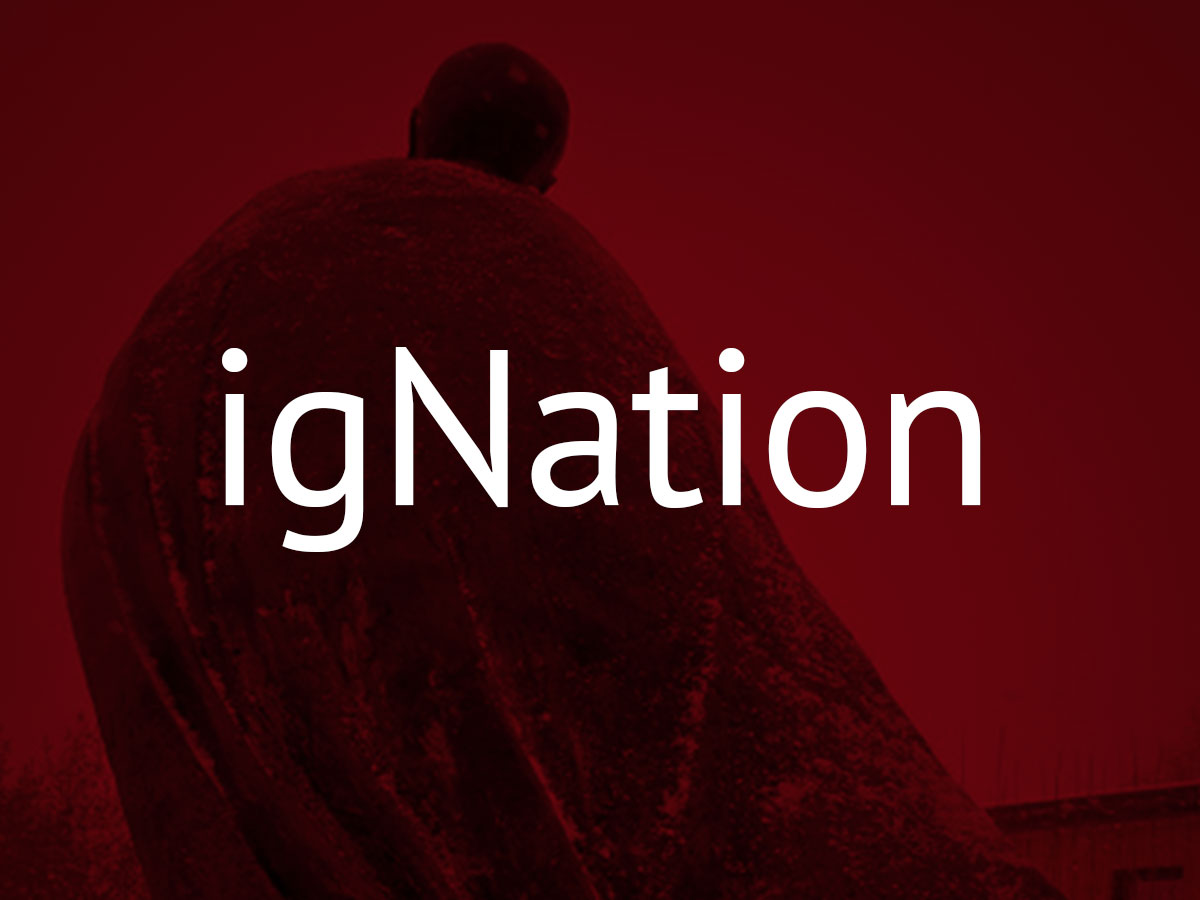
Seven years ago, Fr. Bill Robins, SJ took a summer break from his work in Kathmandu to visit his native Canada. During the summer of 2016, Bill again made a visit to Canada stopping in Ottawa, Toronto and Winnipeg. This summer was different for this time Bill was also able to join with a group of friends and relatives to enjoy a delightful tour of Newfoundland. Bill shares that journey with us.
The Timeline: July 18 – 30, 2016.
The Group:
Sisters and Brother: Ann Rostecki, Louise Rickenbacker, Enid Robins-Holm, Bill Robins
Nephews, nieces, children: Jack Boulet, Mike Boulet Louise Boulet
Grandchild, grand-niece: Anna Rickenbacker Mgunui
Friend: Shane Byrnes
Guides: Ed and Debbie Humber, Executive Cultural Tours
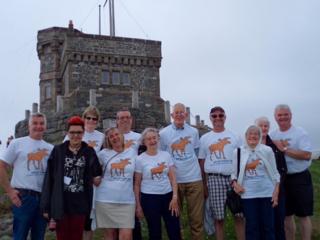
Monday, July 18:
Up early in Toronto and off to Union Station to catch the first train to the airport. I had plenty of time to check in, just as well because the Kathmandu travel agent had mixed up my name. No wonder I could not manage the automatic check-in machines. Earlier faux pas at customs and check-in desks at the Toronto airport reminded me of the challenges first-time travelers must face. The six years since my last arrival have brought many baffling changes to systems!
Westjet got me comfortably to St. John's where I attempted to use the city bus service to get downtown — a bad mistake. I hiked back to the airport arrival area and caught a cab. I arrived at our hotel just as the tour began. Off we went to Cape Spear, the eastern tip of North America, for a windy look at rock and water.
After a stop at picturesque Petty Harbour we drove to Bay Bulls for a boat tour around the island Ecological Reserve. Countless gulls and an eagle entertained us, along with flocks of puffin darting across the waves. Several hump-backed whales, and a pair or two of dolphins kept cameras busy.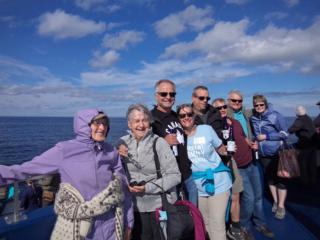
The contrast between cold water, wind and rock, and warm welcomes, set the stage for our tour of this hard yet hospitable land.
Tuesday, July 19:
We devoted the day to the Avalon Peninsula, first climbing Signal Hill with its light house and defenses. We lunched at Quidi Vidi, in downtown St. John's, and spent the afternoon at The Rooms with its moving remembrance of the Newfoundlanders who died in the First World War.
I delighted in watching rowers train for the annual regatta (the first Wednesday of August or the next day of good weather!) on Marine Drive. St. John's shuts down for the event.
I enjoyed wandering through the city but managed to lose my way as I looked for our Jesuit community.
Wednesday, July 20:
We are on the road now, heading north to Trinity Bay, John Cabot's 1497 landing site. On the way our lunch stop is at Clarenville for a Jigg's Dinner, not my favorite but a traditional family feast here. 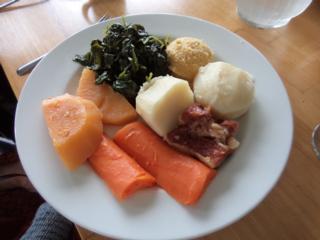
At Trinity we enjoy an afternoon of outdoor entertainment. I walk away marveling at the deep joy of a people who struggle to harvest the sea and who depend on merchants to bring them supplies and to market fish, fur, and meat. The fisher folk remain in debt, yet never give up the joy of a hard, productive life.
Ed kindly arranges for a few of us to catch some cod. Our boat with powerful outboard engines pushes through choppy waters and stops at a good spot our pilot chooses. Soon we haul in our limit for the day. There was not much sport in this pastime. Cod seem to readily offer themselves in sacrifice! Their passive behaviour explains the need for catch limits.
Thursday, July 21:
We enjoy a day on the Bonavista Peninsula, including another light house visit and walks along cliffs, Bonavista Harbour houses a replica to Cabot's "ship," the Matthew. I'm amazed that such a little boat could cross the North Atlantic! Here William Coaker worked to unionize the fishery workers, a step in the right direction. The merchants and fisher folk could then work to find better ways to support one another.
Friday, July 22:
We head west through the Terra Nova National Park and on to Gander, with it's air field so important in World War II. The town became a symbol of Newfoundland hospitality when airline passengers flooded in during the September 2001 crisis. We turned north with a stop at Boyd's Cove for lunch and a chance to learn the sad history of the Beothuk People. These peaceful coastal dwellers preferred to retreat inland than to challenge European newcomers who moved into the best harbours. The last Beothuk passed away in the early 19th century. Could this extinction have been avoided? I'm not in a position to judge, but at least to remind myself to try to understand others before challenging them. May we all learn from past mistakes. After years of life a a visitor adapting to varied cultures, I hope I have learned some of these lessons.
We continue north to Twillingate for a a two-night stay.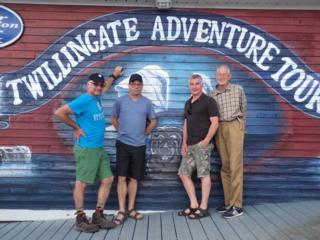
Saturday, July 23:
After compulsory visits to the Crowhead lighthouse and its spectacular views, and another museum, we enjoy a long visit with Dave and Christine who have restored a traditional fish processing facility. Family teams processed the catch before passing it on to merchants in payment of loans. So these people continued the daily grind, hoping to repay the business people before the end of the fishing season, but never quite making enough profit to do so. Dave introduces us to the Ugly Stick, Newfoundland's answer to the modern drum set.
Sunday, July 24:
We work our way west with stops at King's Point to visit a potter's studio, and on to Grand Falls to sudy the lives of the Atlantic Salmon. At Deer Lake we stop at an insectarium to learn more about these six legged animals and to enjoy walking with exotic butterflies. We stop in Corner Brook. with its larger harbour and very clean paper mill.
Monday, July 25:
We enjoy visiting Lark Harbour and time to wander through Corner Brook.
 Tuesday, July 26:
Tuesday, July 26:
We are off north along the west coast, and in mid-afternoon reach L'Anse aux Meadows, the excavated site of a Viking settlement, in use about 1,000 A.D. The visitors seem to have harvested fish and lumber, but preferred not to stay permanently. We stay at St. Anthony.
Wednesday, July 27:
We enjoy learning of Sr. Wilfred Grenfell's lifetime of service to the Newfoundland and Labrador citizens. I take the opportunity to see a doctor at the Grenfell Memorial Hospital so as to convince my sisters that my lingering cold is not life threatening.
This is an interesting cross-cultural experience: a Canadian Jesuit from the prairies, who has spent most of his adult life in the Himalaya, consults a Muslim lady doctor from India at the northern tip of Newfoundland. Her consoling prediction was that I would cure myself in time, but could take anti-biotics to perhaps speed up the process. Hopefully she was right!
We spend the afternoon driving south to Cow Head near Gros Morne National Park. We enjoy some professional theatre, reflections of a Newfoundland nurse serving behind the front lines during World War I. The story is based on her actual letters home. This reflection on the futility of war, and reminded me of the extinction of the Beothuk Nation, again not called for.
Thursday, July 28:
I enjoy a dawn jog along the coast to Rocky Harbour, another tiny yet active fish processing facility. It's impossible to miss God's presence along this beautiful bay.
We drive to Western Brook Pond for a forty-five minute hike and then a boat trip up the Western Brook Gorge. Clouds cover the tops of the cliffs, allowing us to focus on the stunning shoreline while learning of the geological history of this fiord, a leftover of the last ice age when ocean water levels were high. This is now a deep and cold freshwater lake. A landing at the head of the inlet presents a trail head for adventurous hikers. I'll save that for another lifetime.
Friday, July 29:
Off to Bonne Bay. We lunch at Woody Point. There Tom, a member of Ed's folk music trio, the Sharecroppers, offers a lesson on playing the Ugly Stick — a tricky instrument to handle. Young Anna proves to be a worthy student. I stay well back in the crowd! We stop at the Discovery Center to try to absorb a little of the area's geological history. A windy, chilly, but instructive tour of the Tablelands wets my appetite for more hiking. Another time? This area, covered with rock which formed in the earth's mantle, makes the geology of the Himalaya seem so simple and "modern!"
We enjoy our final tour dinner at Trout River, again the best of sea food.
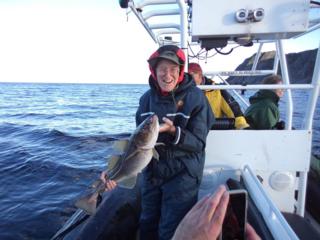 Saturday, July 30:
Saturday, July 30:
Ed and Debbie deliver us to the Deer Lake airport. Jack leave for home, but the rest of the group rent two cars and move to Lonny Holland's chalet at Strawberry Hill, on the Humber River. Lonny is a great friend of the Halifax and Darjeeling Jesuits. He has spent time in the fall of 2015 and 2016 helping at the Darjeeling Province pre-novitiate. I met him in Kathmandu when he had come to visit late Bishop Anthony Sharma. Our team appreciated his hospitality over five days, enjoying more hiking to Gros Morne, golf, walks and rest. Ed and Debbie drove from nearby Pasedena to share a meal with us.
My summer in Canada has included visits with family and friends in Toronto, Ottawa, and Winnipeg, my usual Canadian stops. The two weeks in Newfoundland presented a new experience of Newfoundland's rugged hospitality. Traditional life there is amazingly similar to life in the Himalaya. The land is different, but the challenges similar. Mountains replace the sea, but offer equally hard challenges. Yet the people are similar because their difficult lives help them to work in order to enjoy life in their God-given surroundings together. I hope I can bring that healthy approach to life with me as I return to Nepal.




No Comments